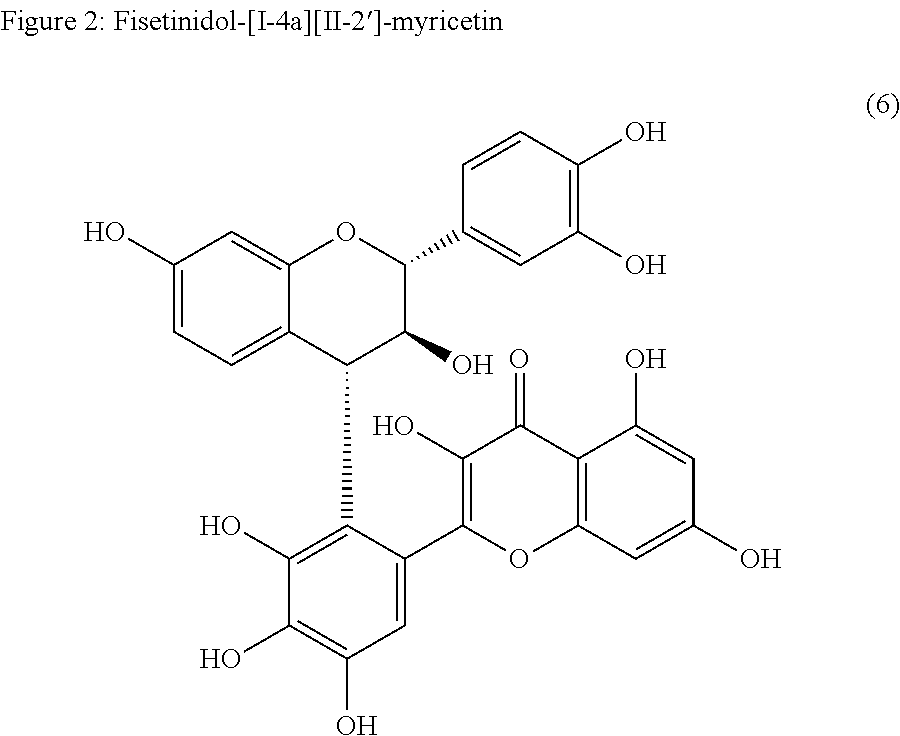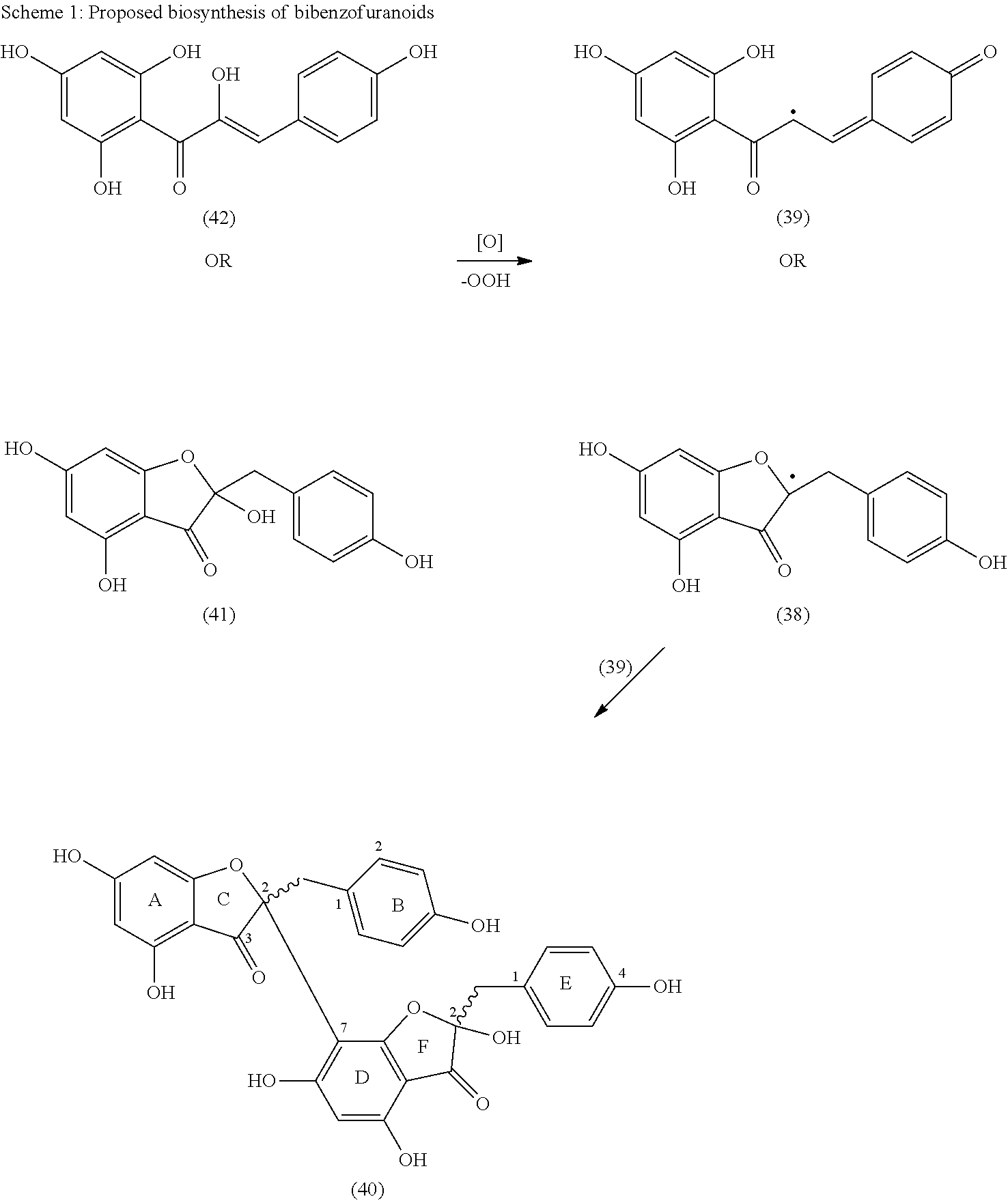Synthesis of C-3 coupled biflavonoids and C-3 coupled biflavonoid analogues
a technology of c-3 coupled biflavonoids and c-3 coupled biflavonoids, which is applied in the field of new process for the preparation of c3 coupled biflavonoids and c3 coupled biflavonoid analogues, can solve the problems of affecting the development of general synthetic methods, unable to synthesize, and unable to achieve the effect of general synthetic methods
- Summary
- Abstract
- Description
- Claims
- Application Information
AI Technical Summary
Benefits of technology
Problems solved by technology
Method used
Image
Examples
example 1
Preparation of 3-arylflav-3-ene
[0186]
[0187]Dried (2R)-5,7,3′,4′-tetrakis(methyloxy)flavan-3-one [1] (100 mg, 0.29 mmol) and 1,3,5-tri-O-methylphloroglucinol (120 mg, 0.710 mmol, 2.5 eq.) were dissolved in dry dichloromethane (10 mL) and the mixture was cooled in ice / NaCl bath. Tin(IV)chloride (1 M solution in dichloromethane, 0.5 mL, 0.5 mmol, 1.7 eq.) was added dropwise to the solution and the reaction mixture was stirred under argon in thawing ice / NaCl bath for 24 hours (TLC monitoring of consumption of starting materials). The reaction mixture was filtered on a basic aluminum oxide pack and washed with ethyl acetate. Purification on silica preparative TLC plates afforded 3-(1,3,5-O-methylphloroglucinol)-5,7,3′,4′-tetramethoxyflavan-3-ene [2] (Rf 0.26, 70.2 mg, 49%).
[0188]1H NMR: δ (DMSO) 3.64-3.80 (s, 21H, 7×OCH3), 5.83 (br, 1H, 4-H), 6.03 (br s, 1H, 2-H), 6.26 (s, 2H, 3″ / 5″-H), 6.33 (d, J=2.0 Hz, 1H, 6-H), 6.69 (dd, J=0.6, 2.0 Hz, 1H, 8-H), 6.78 (dd, J=2.0, 8.3 Hz, 1H, 6′-H), 6....
example 2
Preparation of 3-arylflav-4-one
[0191]
[0192]3-(1,3,5-O-methoxyphloroglucinol)-5,7,3′,4′-tetramethoxyflavan-3-ene (2) (50 mg, 0.10 mmol) was dissolved in THF (5 mL) and OsO4 (3.1 mg, 0.012 mmol) and N-methylmorpholine-N-oxide (56.2 mg, 0.48 mmol) was added. The reaction mixture is stirred 1-2 days at r.t. under argon (TLC monitoring of consumption of starting material). Solution of sodium metabisulfite (10% aq.) was added and reaction mixture was stirred for 30 minutes. Then was made the extraction 3× with dichloromethane, washed with NaHCO3 (sat. aq.), NaCl (sat. aq.) and dried over MgSO4. Evaporation left crude material which was purified on preparative TLC plates to afford 3-(1,3,5-O-methoxyphloroglucinol)-5,7,3′,4′-tetramethoxyflavan-4-one (3) (15 mg, 0.29 mmol, 29%).
[0193]1H NMR: δ (CDCl3) 3.35 (s, 3H, 4″-OMe), 3.63 (s, 6H, 2″ / 6″-OMe), 3.77 (s, 3H, OMe), 3.80 (s, 3H, OMe), 3.81 (s, 3H, OMe), 3.82 (s, 3H, OMe), 5.08 (s, 1H, 6-H), 5.52 (s, 1H, 8-H), 5.85 (d, J=2.3 Hz, 1H, 3-H), 6.0...
example 3
Preparation of (2R)-3-[(2R,3S)-5,7,3′,4′-tetrakis(methyloxy)-3-hydroxyflavan)]-5,7,3′,4′-tetramethoxyflavan-3-ene (6)
[0196]
[0197]Dried (2R)-5,7,3′,4′-tetrakis(methyloxy)flavan-3-one (1) (200 mg, 0.581 mmol) and (2R,3S)-5,7,3′,4′-tetrakis(methyloxy)flavan-3-ol (5) (400 mg, 1.162 mmol, 2 eq.) was dissolved in dry dichloromethane (10 mL) and the mixture was cooled in ice / NaCl bath. Then tin(IV)chloride (1 M solution in dichloromethane, 1 mL, 1 mmol, 1.7 eq.) was added dropwise and the reaction mixture was stirred under argon in thawing ice / NaCl bath for 24 hours (TLC monitoring of consumption of starting materials). The reaction mixture was then filtered on a basic aluminium oxide and washed with ethyl acetate. Purification on silica preparative TLC plates (hexane-ethyl acetate 4:6) afforded (2R)-3-[(2R,3S)-5,7,3′,4′-tetrakis(methyloxy)-3-hydroxyflavan)]-5,7,3′,4′-tetramethoxyflavan-3-ene (6) (Rf 0.20, 40.1 mg, 0.060 mmol, 10%).
[0198]1H NMR: δ (CDCl3) 2.54-2.64 (m, 1H, 4″-H), 3.05-3.15...
PUM
| Property | Measurement | Unit |
|---|---|---|
| optically active | aaaaa | aaaaa |
| optical activity | aaaaa | aaaaa |
| electrophilic | aaaaa | aaaaa |
Abstract
Description
Claims
Application Information
 Login to view more
Login to view more - R&D Engineer
- R&D Manager
- IP Professional
- Industry Leading Data Capabilities
- Powerful AI technology
- Patent DNA Extraction
Browse by: Latest US Patents, China's latest patents, Technical Efficacy Thesaurus, Application Domain, Technology Topic.
© 2024 PatSnap. All rights reserved.Legal|Privacy policy|Modern Slavery Act Transparency Statement|Sitemap



